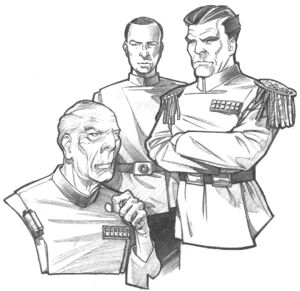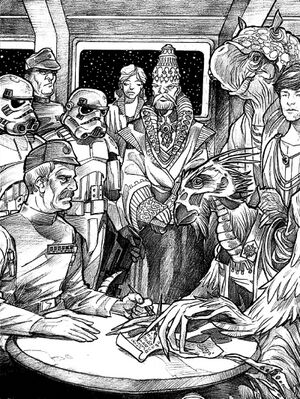Pellaeon–Gavrisom Treaty
- "After more than two decades, the galaxy's most devastating war ended with the muted scratch of a writing stylus."
- ―Voren Na'al
The Pellaeon–Gavrisom Treaty was a historic peace treaty that marked the end of the Galactic Civil War, a conflict between the Galactic Empire and the New Republic. The treaty of peace was signed by the Imperial Remnant's Supreme Commander, Fleet Admiral Gilad Pellaeon, and the New Republic's Acting Chief of State, Senator Ponc Gavrisom, in 19 ABY.
History
Early peace proposals
- "A truce? Are you mad? The Moffs would rebel!"
- ―Admiral Gilad Pellaeon to Feena D'Asta
In the years following the Battle of Endor, Imperial and New Republic forces engaged in several temporary, localized alliances against mutual threats. 4 ABY saw the Bakura Truce against the Ssi-ruuk[6] and the Battle of Saijo against the Tofs,[7] and 7 ABY saw the Battle of Vahaba against the forces of Zsinj.[8]
The first tentative plan for comprehensive peace between the New Republic and Imperial Remnant was proposed by Imperial Admiral Betl Oxtroe to the New Republic Provisional Council in 7 ABY. Oxtroe's proposal would appoint Emperor Palpatine's 11-year old grand-niece Ederlathh Pallopides as the titular Empress, with the former New Republic Councilors holding effective power. Although the New Republic was eager to negotiate, the secret talks soon ended when Oxtroe was assassinated, apparently by Noghri under the direction of Grand Admiral Thrawn.[9]
A truce between the Imperial Remnant and the New Republic was also proposed to Pellaeon in 13 ABY by Baron Ragez D'Asta and his daughter, Feena D'Asta, as the cost of their bringing the D'Astan sector back into the Empire.[10] Pellaeon dispatched Feena D'Asta and Zam Basdor to negotiate with Mirith Sinn and Kir Kanos of the New Republic, but the meeting was disrupted by the Restored Empire faction who succeeded in killing D'Asta.[11]
End of the war
- "It's time to send an emissary to the New Republic. To discuss the terms of our surrender."
- ―Fleet Admiral Gilad Pellaeon to Captain Ardiff
In 17 ABY, after five relatively peaceful years, Imperial systems near the Hydian Way began to suggest the cessation of hostilities. The New Republic Senate was favorable and proposed Imperial officers to keep their offices in case of peace. Fearing an invasion, the Council of Moffs secretly contacted Admiral Natasi Daala, who had unified the replacement warlords, and proposed a campaign against the New Republic. The campaign was disastrous for the Imperial Military and the Imperial Space was reduced to eight remote sectors in the Outer Rim.[13][3]

The final treaty was the brainchild of Pellaeon who, after acknowledging the impossibility of an honorable victory over the New Republic, proposed it to the Imperial Council of Moffs, select officers of the Imperial Starfleet, and other officials who, for the most part, grudgingly agreed.[3] The Braxant sector's Moff, Vilim Disra, though openly siding with Pellaeon, chose to side with Imperial Guardsman Grodin Tierce and a con-artist named Flim to take advantage of the Caamas Document Crisis in order to nearly bring both the New Republic and the Imperial Remnant into separate internal civil wars.[12]
The plan, though, was foiled by agents on both sides. After Pellaeon and Leia Organa Solo engaged in preliminary talks aboard the Millennium Falcon in the Pesitiin system, the signing of the treaty was carried out by Pellaeon and Gavrisom at Bastion aboard the Star Destroyer Chimaera.[1]

Terms of the treaty
The treaty did not outline a surrender of any sort on the side of either the Imperial Remnant or the New Republic; it instead put forth terms that would leave what remained of the Galactic Empire intact but with an end of hostilities between the two rival parties. It additionally opened the Imperial Remnant to trade and commerce with the New Republic, and put forth limitations on smuggling for both governments to enforce. In addition, systems in either government group would be allowed to choose their alignment, satisfying Imperial-loyal systems in New Republic space.[1] The treaty also banned the use of cloaking devices.[3]
Appearances
- Specter of the Past (First mentioned)
- Specter of the Past unabridged audiobook (Mentioned only)
- Vision of the Future (First appearance)
- Vision of the Future unabridged audiobook
- Survivor's Quest (Mentioned only)
- The New Jedi Order: Dark Tide I: Onslaught (Indirect mention only)
- The New Jedi Order: Agents of Chaos I: Hero's Trial (Mentioned only)
- The New Jedi Order: Agents of Chaos II: Jedi Eclipse (Mentioned only)
- The New Jedi Order: Edge of Victory II: Rebirth (Mentioned only)
- The New Jedi Order: Force Heretic I: Remnant (Mentioned only)
- The New Jedi Order: The Unifying Force (Mentioned only)
- Legacy of the Force: Exile (Indirect mention only)
Sources
 "Star Wars Episode VII: Rise of the New Republic"—InQuest Gamer 50 (Indirect mention only)
"Star Wars Episode VII: Rise of the New Republic"—InQuest Gamer 50 (Indirect mention only)- The Essential Chronology
- The Official Star Wars Fact File 5 (THR3, Grand Admiral Thrawn) (Indirect mention only)
- The New Essential Chronology
- The Complete Star Wars Encyclopedia
- The Essential Atlas
- The Essential Guide to Warfare
Notes and references
- ↑ 1.00 1.01 1.02 1.03 1.04 1.05 1.06 1.07 1.08 1.09 1.10 1.11 Vision of the Future
- ↑ The Essential Reader's Companion
- ↑ 3.0 3.1 3.2 3.3 The Essential Guide to Warfare
- ↑ The Essential Chronology
- ↑ Crimson Empire III: Empire Lost 2
- ↑ The Truce at Bakura
- ↑ Star Wars 107
- ↑ X-Wing: Solo Command
- ↑ Dark Empire Sourcebook
- ↑ Crimson Empire III: Empire Lost 2
- ↑ Crimson Empire III: Empire Lost 5
- ↑ 12.0 12.1 Specter of the Past
- ↑ The Essential Atlas